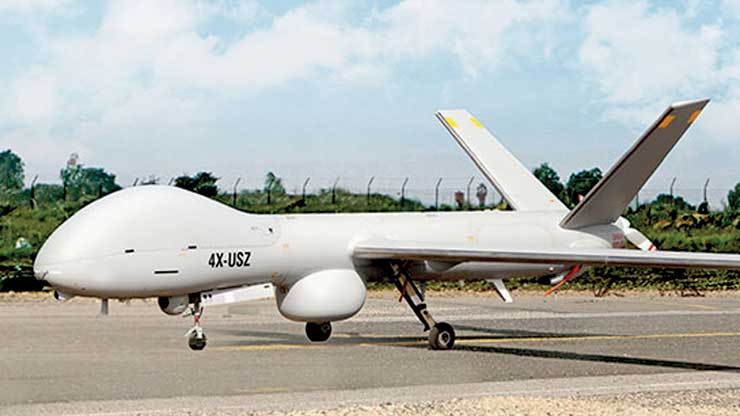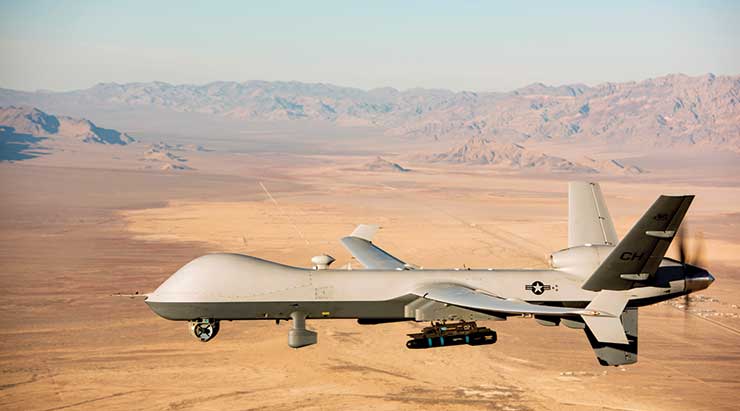
On January 10, 2024, the Indian Navy unveiled the Drishti 10 Starliner unmanned aerial vehicle manufactured by Adani Defence and Aerospace at the company’s Aerospace Park in Hyderabad. Drishti 10 is an advanced ISR (intelligence, surveillance and reconnaissance platform) with 36 hours endurance and 450 kg payload capacity. India’s only all-weather military platform with NATO standardised certification, it is cleared to fly in both segregated and unsegregated airspace.
What is remarkable about Drishti 10 is the speed of its development. From the Ministry of Defence awarding the contract to field testing by the Indian Navy, it took just 10 months. In a country where the defence public sector companies take decades to produce weapons platforms, this is nothing less than stupendous.
Commenting on Adani Defence’s efforts in establishing an ecosystem of partners and capabilities to fastrack the UAS project, navy chief Admiral R Hari Kumar said: “This is a momentous occasion and a transformative step in India’s quest for self-reliance in ISR technology and maritime supremacy. Drishti 10’s integration into our naval operations will enhance our naval capabilities, strengthening our preparedness for the ever evolving maritime surveillance and reconnaissance.”
Building Indigenous Capabilities
India’s pursuit of Aatmanirbharta is happening even as the country’s armed forces leverage UAS for a wide spectrum of roles such as drone warfare, border patrol, counter-terrorism operations and strategic surveillance, thereby enhancing situational awareness, strike capability and operational effectiveness.
The DRDO, along with other research institutions and private players, are actively engaged in designing and manufacturing advanced drones tailored to meet diverse operational requirements. Projects like the Rustom series, Lakshya and the Ghatak UCAV (Unmanned Combat Aerial Vehicle) exemplify India’s progress in developing indigenous UAS platforms.
While prioritising indigenous development, India also recognises the value of strategic partnerships and collaborations in fostering innovation and technology transfer. Collaborative ventures with international partners bring access to cutting-edge technologies, expertise and global best practices, thereby augmenting capabilities in UAS design, manufacturing and operations. These partnerships not only accelerate the pace of innovation but also contribute to building a robust ecosystem for indigenous production and export of UAS.
While prioritising indigenous development, India also recognises the value of strategic partnerships and collaborations in fostering innovation and technology transfer. Collaborative ventures with international partners bring access to cutting-edge technologies, expertise and global best practices, thereby augmenting capabilities in UAS design, manufacturing and operations
As part of the Aatmanirbhar Bharat initiative, the government has sanctioned the Production-Linked Incentive (PLI) scheme, allocating Rs 120 crore over three fiscal years for drones and drone components. A provisional list of 23 PLI beneficiaries, including 12 drone manufacturers and 11 drone component manufacturers, has been released by the government. Additionally, the FY 2022-23 budget introduced the Drone Shakti scheme to foster start-ups in Drone-As-A-Service (DrAAS) and announced skilling courses in select ITIs across all states.
The involvement of the private sector in the military drone industry is expected to provide a significant strategic advantage to Indian defence. Presently, India boasts over 200 drone startups, a number anticipated to grow substantially given the sector’s potential and evolving technology. To ensure a proficient pool of drone operators, various government and private institutions have initiated training programmes. Notably, the Indira Gandhi Rashtriya Uran Akademi, an autonomous body under the Ministry of Civil Aviation and one of the nation’s largest flight training organisations, commenced Directorate General of Civil Aviation (DGCA) certified training at India’s inaugural and exclusive drone flying site in Gurugram in February 2021.
Strategic Aspect
Military drones are the new eyes in the sky over the battlefield and provide reconnaissance that can’t be provided by manned aircraft. Admiral Kumar calls the Drishti-10 the “third eye” in the maritime domain. UAVs, such as the US Reaper-9 can loiter for up to 42 hours on internal fuel and potentially indefinitely with aerial refuelling. The Indian Army has acquired Israeli drones, which now keep constant vigil on the borders. Significantly, there are now more hours flown by America’s military drones than by its manned strike aircraft and more pilots are being trained to fly them than their manned equivalents.
According to Strategy Page, “Micro UAVs can be deployed in large numbers, often by small infantry units or by artillery spotters, granting frontline ground units fast, easy, cheap and direct access to a part of surveillance capabilities that before had to be requested from and organised by higher level headquarters, which often prevented the vital intelligence from arriving to the ground troops in time.” A US Air Force document “Unmanned Aircraft Systems Flight Plan 2009-2047” predicts drones of the future would be built around common airframes of differing size incorporating a modular, “open-architecture” approach so they could be as flexible as possible.
The largest of these drones would “operate as airborne warning and control aircraft (AWACs), aerial refuelling tankers, strategic lift transports and long-range bombers.” The next generation of drones will also have artificial intelligence giving them a high degree of operational autonomy including the ability to shoot to kill.
On March 22, 2023, Ukrainian forces raided Russia’s Sevastopol harbour using seaborne and airborne UAVs – an ingenious employment of emerging and disruptive technology. However, the Russian Navy was prepared and the raid did not produce the desired results. Despite the mission’s failure, it forced the Russian Navy to become more defensive.
India has approved the acquisition of 31 high-altitude long-endurance unmanned aerial vehicles for all three services. As part of this roadmap, both the Navy and Army will get two Drishti-10 each in the next few months
In this backdrop, India has approved the acquisition of 31 HALE (high-altitude long-endurance) unmanned aerial vehicles for all three services. As part of this roadmap, both the Navy and Army will get two Drishti-10 each in the next few months. This highlights a key transformation of the modern battlefield – in the area of real time theatre reconnaissance, modern armies and navies are now almost completely independent of the air force.
The question that remains unanswered is who gets majority control of these new – and potentially game changing – weapons. Will it be the air force, army, navy or a purpose built service? Will these new UAS platforms lead to turf wars between the various services? This is not a farfetched scenario – in 2012 the IAF suffered a major setback when the government agreed to transfer most of its attack helicopters to the Indian Army. In all, the army got control of over 270 armed helicopters while the IAF was left with just a dozen or so helicopter gunships.

Regional Rivalry
Aatmanirbharta in defence UAS is urgently needed in the backdrop of India’s adversaries possessing significant drone warfare capability. According to a report in the New Delhi-based Manohar Parrikar Institute for Defence Studies and Analyses, India is at least a decade behind Pakistan and even further behind China in the sector. Both Pakistan and China have been closely collaborating in the development of and acquisition of various military platforms and weapons, including combat drones.
“China had relied on UAVs and built a robust aviation programme right from the 1950s. Government support, reliable infrastructure, quality education, research and development have collectively helped China in this domain. Collaboration and joint ventures with other countries and clandestine operations also aided China in its objectives. Pakistan on the other side owes the development of its programme to the PSUs and support extended by China,” says the report.
Civil Applications
Beyond defence, UAS hold immense potential for civil applications spanning agriculture, infrastructure monitoring, disaster management, environmental conservation, and aerial logistics. India’s agricultural sector, in particular, stands to benefit significantly from the adoption of UAS for precision farming, crop monitoring, and pest control, thereby improving productivity and sustainability. Similarly, UAS-enabled aerial surveys and monitoring expedite infrastructure development projects while minimising costs and risks associated with conventional methods. The civil market is likely to be several orders of magnitude larger than the military one and therefore will provide an added fillip to the UAS sector.
India’s pursuit of Aatmanir-bharta in unmanned aircraft systems reflects its commitment to harnessing indigenous innovation and technology for national development and security. By fostering indigenous capabilities, nurturing strategic partnerships and addressing regulatory challenges, the country is poised to emerge as a key player in the global UAS market
Regulatory Framework and Ecosystem Support
Realising the transformative potential of UAS, India has established a conducive regulatory framework and ecosystem support to facilitate their safe and efficient integration into airspace. The DGCA has formulated regulations governing UAS operations, ensuring compliance with safety standards and privacy norms. Furthermore, initiatives like the National Drones Portal and UAS Traffic Management (UTM) systems are fostering a conducive ecosystem for UAS innovation, testing and deployment.
Challenges and Way Forward
Despite significant strides, India’s journey towards Aatmanirbharta in UAS is not without challenges. Technical complexities, regulatory constraints, cybersecurity concerns and the need for skilled manpower pose formidable hurdles that require concerted efforts from government, industry and academia. Addressing these challenges necessitates continued investments in research and development, capacity building, and collaborative partnerships to propel India towards technological self-reliance and global leadership in unmanned aircraft systems.
On a positive note, both the public and private sector are involved in UAS development. Says the IDSA report: “While India is establishing a strong aviation ecosystem by bringing together all stakeholders, including the government, promotional bodies, DPSUs, tri-services, academia and industry partners, experts believe that in the next 10 to 15 years, private Indian industries will be the crusaders for the government in defence production, particularly in the UAV vertical. Correlation between industries and the economy will also be crucial in the future.”
Conclusion
India’s pursuit of Aatmanirbharta in unmanned aircraft systems reflects its commitment to harnessing indigenous innovation and technology for national development and security. By fostering indigenous capabilities, nurturing strategic partnerships and addressing regulatory challenges, the country is poised to emerge as a key player in the global UAS market while catering to diverse defence and civil applications. As India accelerates its journey towards self-reliance in this critically important sector, it not only strengthens its defence posture but also unlocks new avenues for economic growth, employment and innovation.
– The writer is a globally cited defence analyst. His work has been published by leading think tanks, and quoted extensively in books on diplomacy, counter terrorism, warfare and economic development. The views expressed are of the writer and do not necessarily reflect the views of Raksha Anirveda















